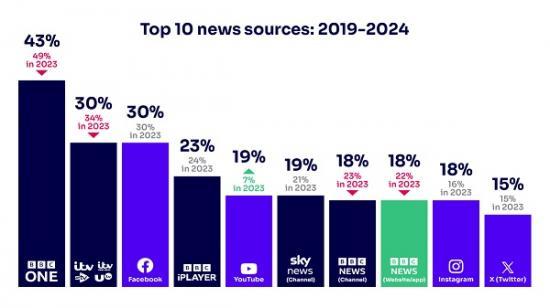TV Loses Its Crown As Main Source For News
10th September 2024

Television is no longer the single main source of news for UK adults, as Ofcom research shows online sites and apps are now as popular as TV news for the first time.
TV has been considered the leading source of UK news since the 1960s, when widespread set ownership saw it overtake radio and newspapers. But Ofcom's annual study into how we access news shows that 71% of adults now do so online, compared to 70% for TV, marking a generational shift in the balance of news media.
The big driving factor is the increasing use of social media for news.[1] More than half of UK adults (52%) now use platforms such as Facebook, YouTube and Instagram to access news, up from 47% in 2023.
Once the dominant feature of the nation's news diets, the reach of TV news has gradually declined in recent years, and fell sharply from 75% to 70% last year.
Older generations turn to news sites
Going online is by far the most popular way for younger people to access news (88% of 16-24-year-olds), but older generations are also gradually adding online sources to their news diets.
Over half (54%) of people aged 55+ find news online - up from 45% in 2018 - with most navigating directly to news websites. Only 28% access news via social media, significantly lower than 16-24s at 82%.
Despite this trend towards online news sources, TV remains by far the leading platform for news among older age groups (85%), compared to only half of 16-24s (49%).
Public service broadcasters (PSBs) remain an important way to access news. BBC One remains the most popular individual news source, while news across all BBC platforms (TV, radio, news website, Sounds and iPlayer) still reaches 68% of all UK adults. ITV1 is the second most popular individual news source.
But use of both channels for news has gradually declined over the last five years (see table above). Channel 4 has fallen out of the top 10 rankings for the first time, with news usage down from 17% in 2019 to 14% in 2024.
Four of the ten most popular news sources are the social media services Facebook, YouTube, Instagram and X (see table). Among 16-24-year-olds, these platforms plus TikTok occupy all top five spots.[2] YouTube is now as widely used to access news content as the Sky News Channel and more popular than the BBC News Channel and BBC News Online.
Broadcast news trusted and valued, with review underway to secure its future
Online news sources - and social media platforms in particular - are rated much less favourably than traditional platforms such as TV and radio for accuracy, trust and impartiality (see table below).
Audiences still consider ‘trusted and accurate UK news' as the most important societal feature of public service media (PSM), with nearly half of respondents (49%) ranking it among the top three attributes.[3] Our research also shows that PSBs, on the whole, consistently deliver well in this area, with 63% of respondents rating PSB news as ‘trusted and accurate'.
Ofcom wants to support the availability of trusted and valued PSM news where people consume it, so today we are setting the framework for our next review of public service media. This will build on the findings from our last review - Small Screen: Big Debate – which saw many of our recommendations to Government put in place through the recent Media Act 2024.
The first phase of our review will look at how well PSBs have delivered for UK audiences, including how PSB news is made available to audiences online. The second phase will consider potential options for changes in regulation or legislation to support public service media in the future.
ih-Choung Teh. Ofcom Group Director, Strategy and Research said, "Television has dominated people's news habits since the sixties, and it still commands really high trust. But we're witnessing a generational shift to online news, which is often seen as less reliable - together with growing fears about misinformation and deepfake content. Ofcom wants to secure high-quality news for the next generation, so we're kicking off a review of the public service media that help underpin the UK's democracy and public debate."
How people followed the General Election
Ofcom has also researched news consumption during the 2024 General Election period. We tracked UK adults' engagement with news, the role of media in helping them form opinions, and experiences of potential misinformation. Our findings included:
Nine in ten followed the election, with younger adults especially engaged. The biggest increase in news interest during the election period was among younger adults aged 18-24 – up to 58% compared to 39% in normal periods. Conversely, older adults aged 50+, women, and those in lower socio-economic households, were all more likely than usual to be uninterested in news during the election period.
Most people saw misleading content. Six in ten (60%) recalled having seen information they felt was false or misleading. Of these, one in ten said they saw this kind of content several times a day.
Worries about deepfake video and audio. Over half of people (57%) expressed concern about the impact of deepfake content during the General Election campaign. More than a quarter (27%) of adults claimed they had encountered a deepfake during the previous week.
Notes to editors:
When reading this report, when a respondent indicates that they use online or social media platforms for news, they may be referring to content or posts by traditional news publishers such as the BBC, posts by journalists or public figures, or content posted/shared by friends and family, etc.
Instagram (41%), YouTube (37%), Facebook (35%), TikTok (33%) and ‘X' (27%)
Ofcom's Public Service Media Tracker 2023.
Read the full Ofco report with more links and graphs HERE
